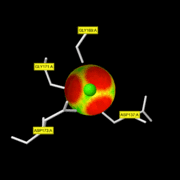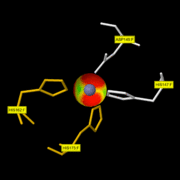Sandbox Reserved 1125
From Proteopedia
(Difference between revisions)
| Line 61: | Line 61: | ||
== Mechanism == | == Mechanism == | ||
| - | To express collagenolytic activity, MMP-8 needs to have both the catalytic and hemopexin domains but it is not clear how the hemopexin domain help to cleave triple-helical collagens because it does not bind to collagen.<ref>PMID:8489511</ref> Moreover, MMP-8 is secreted as inactive proproteins and then activated after a cleavage by extracellular proteinases. Indeed, it can't be activated without removal of the activation peptide. But recent evidences suggest that this protease activation is blocked by the formation of an intramolecular complex between the propeptide domain on the Cysteine residue and essential zinc atom in the catalytic domain. It is called the ''Cysteine-switch''. This discovery is unprecedented in enzymology and offers the opportunity for multiple modes of physiological activation of | + | To express collagenolytic activity, MMP-8 needs to have both the catalytic and hemopexin domains but it is not clear how the hemopexin domain help to cleave triple-helical collagens because it does not bind to collagen.<ref>PMID:8489511</ref> Moreover, MMP-8 is secreted as inactive proproteins and then activated after a cleavage by extracellular proteinases. Indeed, it can't be activated without removal of the activation peptide. But recent evidences suggest that this protease activation is blocked by the formation of an intramolecular complex between the propeptide domain on the Cysteine residue and essential zinc atom in the catalytic domain. It is called the ''Cysteine-switch''. This discovery is unprecedented in enzymology and offers the opportunity for multiple modes of physiological activation of MMP-8. Moreover, since conditions in different cells and tissues may match those necessary to effect one of these activation modes for a given MMP, this may offer metabolic flexibility in the control of MMP activation.<ref>PMID:2164689</ref> |
| - | + | To allow cleavage of the individual alpha chains of collagen, the binding of activated MMP-8 must partially unwind triple helix by inducing a conformational change in alpha chain. However, the molecular basis of this mechanism is not known.<ref>PMID:6270090</ref> | |
| - | + | ||
| - | + | ||
| - | + | ||
| - | To allow cleavage of the individual alpha chains of collagen, the binding of | + | |
The carbonyl group of the peptide bond coordinates with the active-site zinc. This displaces the water molecule from the zinc atom. The peptide hydrolysis is assisted by the carboxyl group of the glutamate, which serves as a general base to draw a proton from the displaced water molecule, thereby facilitating the nucleophilic attack of the water molecule on the carbonyl carbon of the peptide scissile bond. A pocket to the right of the active-site zinc, called the specificity pocket or <scene name='71/719866/S1prime_pocket/1'>S1' pocket</scene>, accommodates the side chain of the substrate residue, which becomes the new N-terminus after cleavage. The sizes of the S1′ pocket vary among the MMPs, and this is one of the major determining factors of substrate specificity.<ref>PMID:12730128</ref> | The carbonyl group of the peptide bond coordinates with the active-site zinc. This displaces the water molecule from the zinc atom. The peptide hydrolysis is assisted by the carboxyl group of the glutamate, which serves as a general base to draw a proton from the displaced water molecule, thereby facilitating the nucleophilic attack of the water molecule on the carbonyl carbon of the peptide scissile bond. A pocket to the right of the active-site zinc, called the specificity pocket or <scene name='71/719866/S1prime_pocket/1'>S1' pocket</scene>, accommodates the side chain of the substrate residue, which becomes the new N-terminus after cleavage. The sizes of the S1′ pocket vary among the MMPs, and this is one of the major determining factors of substrate specificity.<ref>PMID:12730128</ref> | ||
Revision as of 07:57, 29 January 2016
MMP-8
MMP-8, also called, Neutrophil collagenase or Collagenase 2, is a zinc-dependent and calcium-dependent enzyme. It belongs to the matrix metalloproteinase (MMP) family which is involved in the breakdown of extracellular matrix in embryonic development, reproduction, and tissue remodeling, as well as in disease processes, such as arthritis and metastasis. The gene coding this family is localized on the chromosome 11 of Homo sapiens.[1]
| |||||||||||
References
- ↑ "MMP-8 matrix metallopeptidase 8 (neutrophil collagenase)"
- ↑ "Metalloendopeptidase activity"
- ↑ Stams T, Spurlino JC, Smith DL, Wahl RC, Ho TF, Qoronfleh MW, Banks TM, Rubin B. Structure of human neutrophil collagenase reveals large S1' specificity pocket. Nat Struct Biol. 1994 Feb;1(2):119-23. PMID:7656015
- ↑ 4.0 4.1 Substrate specificity of MMPs
- ↑ Bode W, Reinemer P, Huber R, Kleine T, Schnierer S, Tschesche H. The X-ray crystal structure of the catalytic domain of human neutrophil collagenase inhibited by a substrate analogue reveals the essentials for catalysis and specificity. EMBO J. 1994 Mar 15;13(6):1263-9. PMID:8137810
- ↑ Bode W, Reinemer P, Huber R, Kleine T, Schnierer S, Tschesche H. The X-ray crystal structure of the catalytic domain of human neutrophil collagenase inhibited by a substrate analogue reveals the essentials for catalysis and specificity. EMBO J. 1994 Mar 15;13(6):1263-9. PMID:8137810
- ↑ Hirose T, Patterson C, Pourmotabbed T, Mainardi CL, Hasty KA. Structure-function relationship of human neutrophil collagenase: identification of regions responsible for substrate specificity and general proteinase activity. Proc Natl Acad Sci U S A. 1993 Apr 1;90(7):2569-73. PMID:8464863
- ↑ Knauper V, Osthues A, DeClerck YA, Langley KE, Blaser J, Tschesche H. Fragmentation of human polymorphonuclear-leucocyte collagenase. Biochem J. 1993 May 1;291 ( Pt 3):847-54. PMID:8489511
- ↑ Van Wart HE, Birkedal-Hansen H. The cysteine switch: a principle of regulation of metalloproteinase activity with potential applicability to the entire matrix metalloproteinase gene family. Proc Natl Acad Sci U S A. 1990 Jul;87(14):5578-82. PMID:2164689
- ↑ Welgus HG, Jeffrey JJ, Eisen AZ. Human skin fibroblast collagenase. Assessment of activation energy and deuterium isotope effect with collagenous substrates. J Biol Chem. 1981 Sep 25;256(18):9516-21. PMID:6270090
- ↑ Visse R, Nagase H. Matrix metalloproteinases and tissue inhibitors of metalloproteinases: structure, function, and biochemistry. Circ Res. 2003 May 2;92(8):827-39. PMID:12730128 doi:http://dx.doi.org/10.1161/01.RES.0000070112.80711.3D
- ↑ Knauper V, Docherty AJ, Smith B, Tschesche H, Murphy G. Analysis of the contribution of the hinge region of human neutrophil collagenase (HNC, MMP-8) to stability and collagenolytic activity by alanine scanning mutagenesis. FEBS Lett. 1997 Mar 17;405(1):60-4. PMID:9094424
- ↑ "Neutrophil collagenase"
- ↑ "Extra Binding Region Induced by Non-Zinc Chelating Inhibitors into the S1′ Subsite of Matrix Metalloproteinase 8"
- ↑ Balbin M, Fueyo A, Knauper V, Pendas AM, Lopez JM, Jimenez MG, Murphy G, Lopez-Otin C. Collagenase 2 (MMP-8) expression in murine tissue-remodeling processes. Analysis of its potential role in postpartum involution of the uterus. J Biol Chem. 1998 Sep 11;273(37):23959-68. PMID:9727011
RESSOURCE : Image:2oy4 mm1.pdb ( la structure du monomère )


